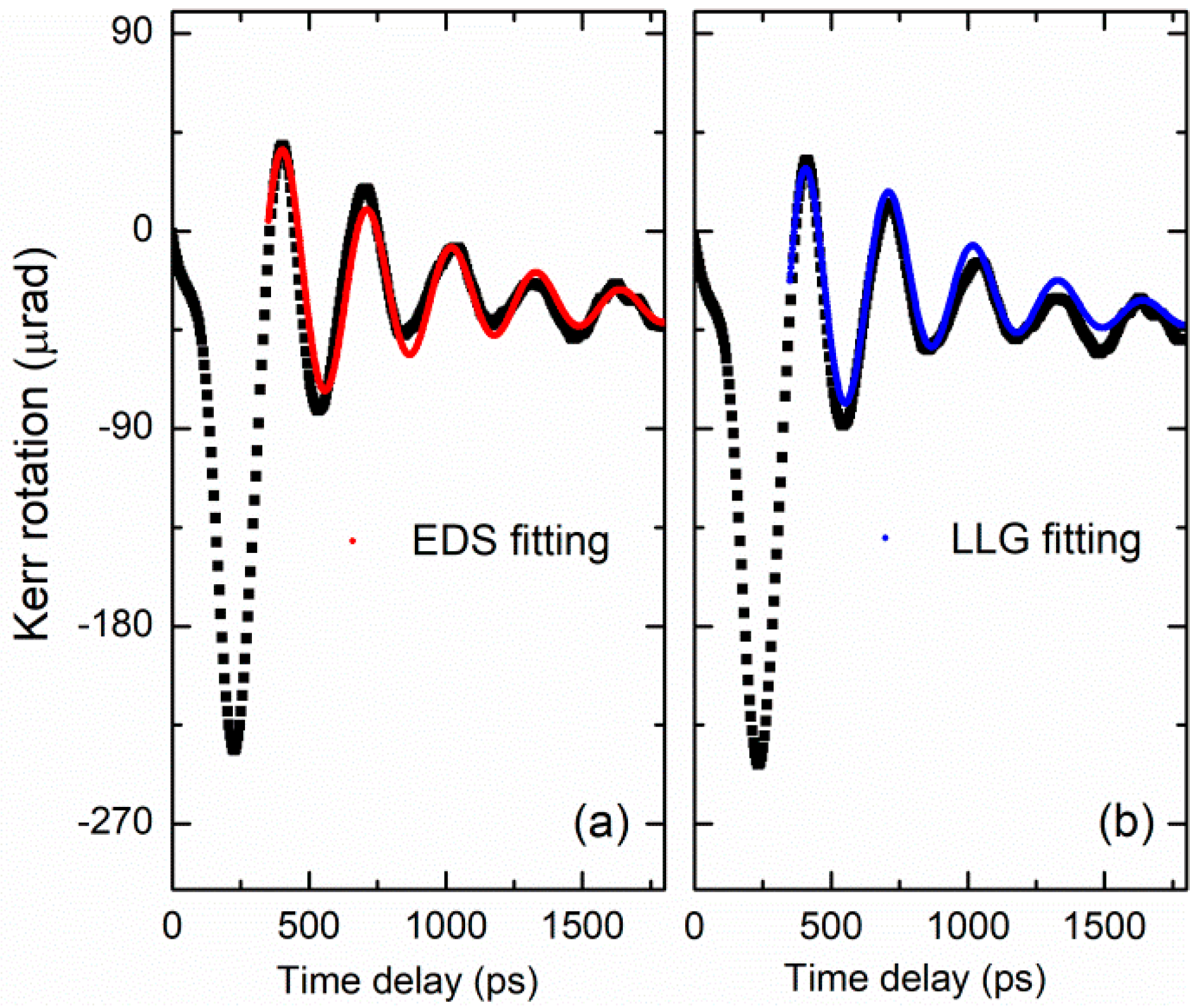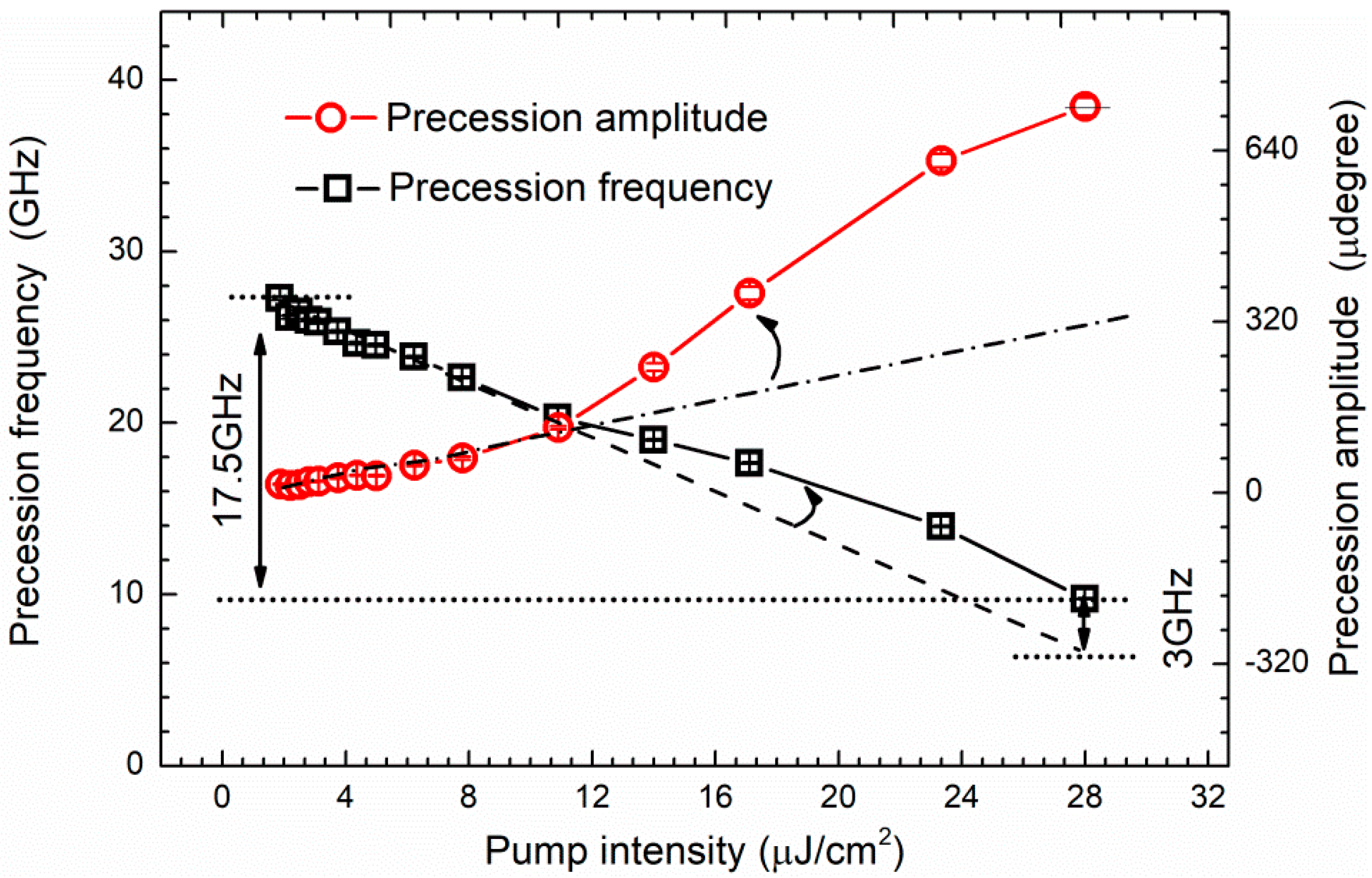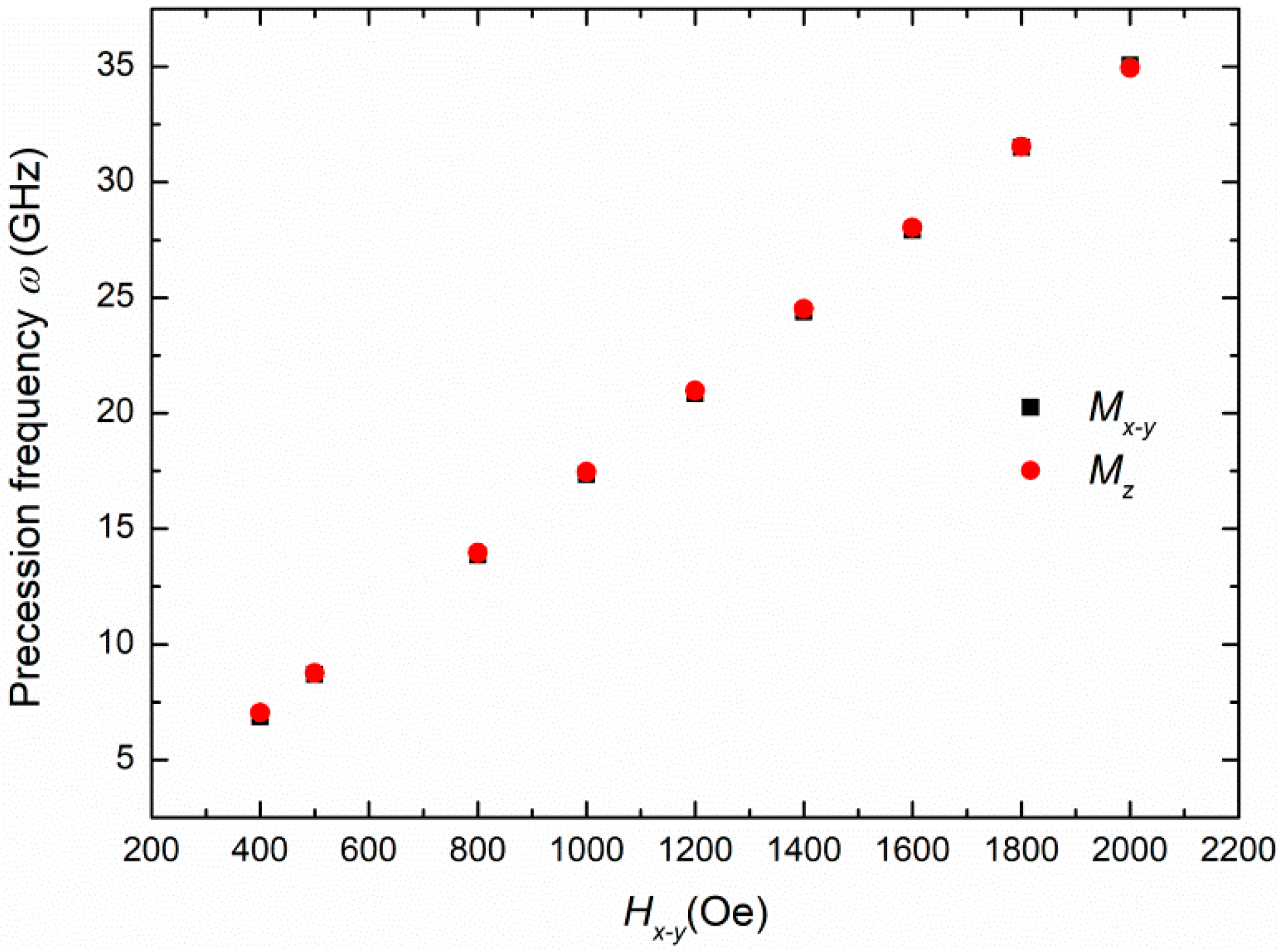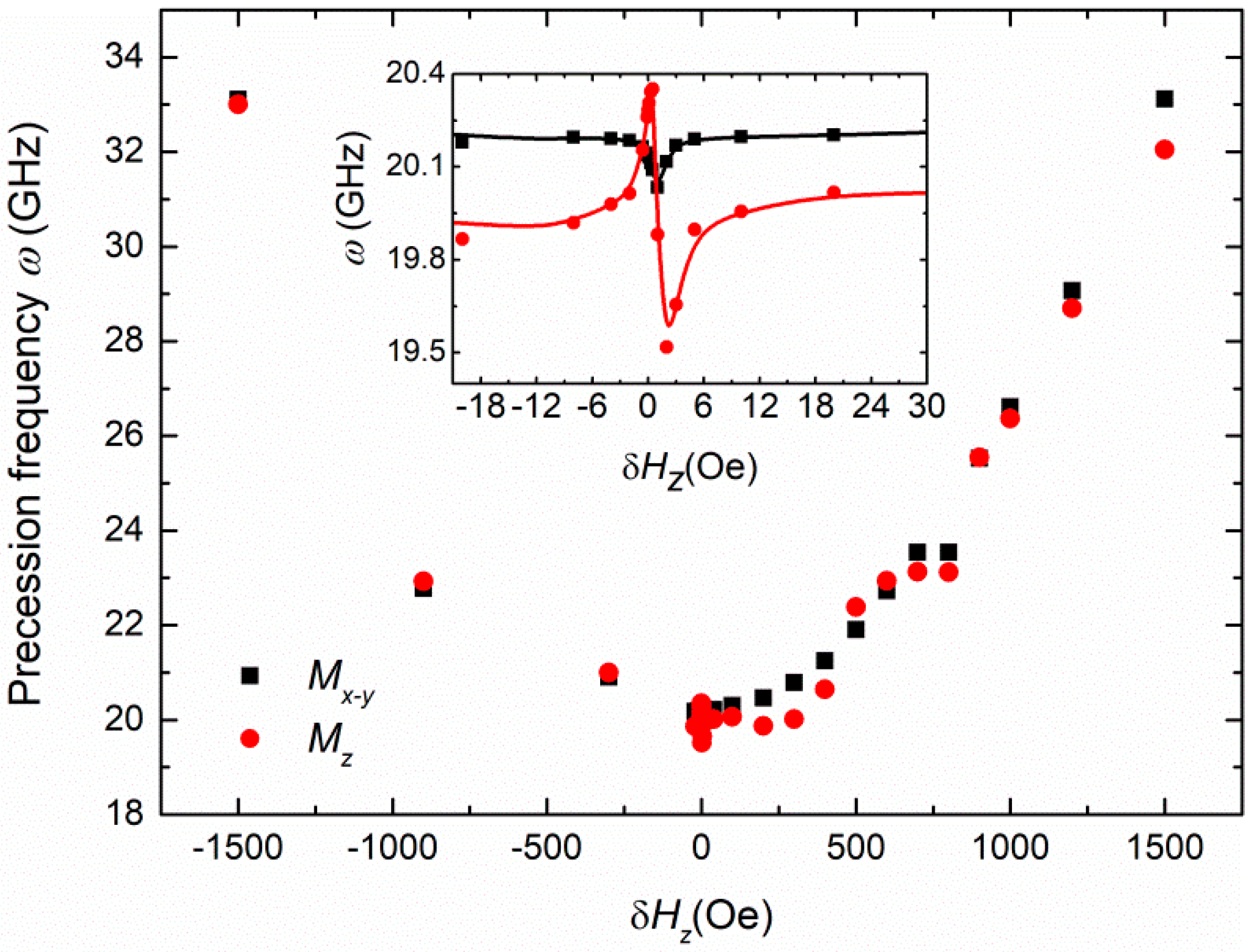Ultrafast Modulation of Magnetization Dynamics in Ferromagnetic (Ga, Mn)As Thin Films
Abstract
1. Introduction
2. Materials and Methods
3. Results
4. Discussion
5. Conclusions
Author Contributions
Funding
Acknowledgments
Conflicts of Interest
References
- Hillebrands, B.; Ounadjela, K. Spin Dynamics in Confined Magnetic Structures I; Springer: Berlin/Heidelberg, Germany, 2002; ISBN 978-3-540-40907-6. [Google Scholar]
- Ramsay, A.J.; Roy, P.E.; Haigh, J.A.; Otxoa, R.M.; Irvine, A.C.; Janda, T.; Campion, R.P.; Gallagher, B.L.; Wunderlich, J. Optical Spin-Transfer-Torque-Driven Domain-Wall Motion in a Ferromagnetic Semiconductor. Phys. Rev. Lett. 2015, 114, 067202. [Google Scholar] [CrossRef] [PubMed]
- Muneta, I.; Kanaki, T.; Ohya, S.; Tanaka, M. Artificial control of the bias-voltage dependence of tunnelling-anisotropic magnetoresistance using quantization in a single-crystal ferromagnet. Nat. Commun. 2017, 8, 15387. [Google Scholar] [CrossRef] [PubMed]
- Kirilyuk, A.; Kimel, A.V.; Rasing, T. Ultrafast optical manipulation of magnetic order. Rev. Mod. Phys. 2010, 82, 2731–2784. [Google Scholar] [CrossRef]
- Lao, Y.F.; Perera, A.G.U.; Wang, H.L.; Zhao, J.H.; Jin, Y.J.; Zhang, D.H. Optical characteristics of p-type GaAs-based semiconductors towards applications in photoemission infrared detectors. J. Appl. Phys. 2016, 119, 105304. [Google Scholar] [CrossRef]
- Luo, J.; Xiang, G.; Gu, G.; Zhang, X.; Wang, H.; Zhao, J. Li(Zn,Mn)As as a new generation ferromagnet based on a I–II–V semiconductor. J. Magn. Magn. Mater. 2017, 422, 124. [Google Scholar] [CrossRef]
- Jungwirth, T.; Sinova, J.; Mašek, J.; Kučera, J.; MacDonald, A.H. Theory of ferromagnetic (III,Mn)V semiconductors. Rev. Mod. Phys. 2006, 78, 809. [Google Scholar] [CrossRef]
- Dietl, T. A ten-year perspective on dilute magnetic semiconductors and oxides. Nat. Mater. 2010, 9, 965–974. [Google Scholar] [CrossRef] [PubMed]
- Li, H.; Zhang, X.; Liu, X.; Furdyna, J.K. The observation of phase reversal in photo-induced coherent spin dynamics in ferromagnetic semiconductor (Ga,Mn)As thin film. Solid State Commun. 2015, 221, 45. [Google Scholar] [CrossRef]
- Němec, P.; Rozkotová, E.; Tesařová, N.; Trojánek, F.; DeRanieri, E.; Olejník, K.; Zemen, J.; Novák, V.; Cukr, M.; Malý, P.; et al. Experimental observation of the optical spin transfer torque. Nat. Phys. 2012, 8, 411. [Google Scholar] [CrossRef]
- Qi, J.; Xu, Y.; Tolk, N.H.; Liu, X.; Furdyna, J.K.; Perakis, I.E. Coherent magnetization precession in GaMnAs induced by ultrafast optical excitation. Appl. Phys. Lett. 2007, 91, 112506. [Google Scholar] [CrossRef]
- Rozkotová, E.; Němec, P.; Horodyská, P.; Sprinzl, D.; Trojánek, F.; Malý, P.; Novák, V.; Olejník, K.; Cukr, M.; Jungwirth, T. Light-induced magnetization precession in GaMnAs. Appl. Phys. Lett. 2008, 92, 122507. [Google Scholar] [CrossRef]
- Hashimoto, Y.; Kobayashi, S.; Munekata, H. Photoinduced Precession of Magnetization in Ferromagnetic (Ga,Mn)As. Phys. Rev. Lett. 2008, 100, 067202. [Google Scholar] [CrossRef] [PubMed]
- Qi, J.; Xu, Y.; Steigerwald, A.; Liu, X.; Furdyna, J.K.; Perakis, I.E.; Tolk, N.H. Ultrafast laser-induced coherent spin dynamics in ferromagnetic Ga1−xMnxAs/GaAs structures. Phys. Rev. B 2009, 79, 085304. [Google Scholar] [CrossRef]
- Guidoni, L.; Beaurepaire, E.; Bigot, J.-Y. Magneto-optics in the Ultrafast Regime: Thermalization of Spin Populations in Ferromagnetic Films. Phys. Rev. Lett. 2002, 89, 017401. [Google Scholar] [CrossRef] [PubMed]
- Stamm, C.; Kachel, T.; Pontius, N.; Mitzner, R.; Quast, T.; Holldack, K.; Khan, S.; Lupulescu, C.; Aziz, E.F.; Wietstruk, M.; et al. Femtosecond modification of electron localization and transfer of angular momentum in nickel. Nat. Mater. 2007, 6, 740–743. [Google Scholar] [CrossRef] [PubMed]
- Müller, G.M.; Walowski, J.; Djordjevic, M.; Miao, G.-X.; Gupta, A.; Ramos, A.V.; Gehrke, K.; Moshnyaga, V.; Samwer, K.; Schmalhorst, J.; et al. Spin polarization in half-metals probed by femtosecond spin excitation. Nat. Mater. 2009, 8, 56–61. [Google Scholar] [CrossRef] [PubMed]
- Kapetanakis, M.D.; Perakis, I.E.; Wickey, K.J.; Piermarocchi, C.; Wang, J. Femtosecond Coherent Control of Spins in (Ga,Mn)As Ferromagnetic Semiconductors Using Light. Phys. Rev. Lett. 2009, 103, 047404. [Google Scholar] [CrossRef] [PubMed]
- Tesařová, N.; Němec, P.; Rozkotová, E.; Zemen, J.; Janda, T.; Butkovičová, D.; Trojánek, F.; Olejník, K.; Novák, V.; Malý, P.; et al. Experimental observation of the optical spin–orbit torque. Nat. Photon. 2013, 7, 492–498. [Google Scholar] [CrossRef]
- Lingos, P.C.; Wang, J.; Perakis, I.E. Manipulating femtosecond spin-orbit torques with laser pulse sequences to control magnetic memory states and ringing. Phys. Rev. B 2015, 91, 195203. [Google Scholar] [CrossRef]
- Li, H.; Liu, X.; Zhou, Y.; Furdyna, J.K.; Zhang, X. Collective magnetization dynamics in ferromagnetic (Ga,Mn)As mediated by photoexcited carriers. Phys. Rev. B 2015, 91, 195204. [Google Scholar] [CrossRef]
- Hashimoto, Y.; Munekata, H. Coherent manipulation of magnetization precession in ferromagnetic semiconductor (Ga,Mn)As with successive optical pumping. Appl. Phys. Lett. 2008, 93, 202506. [Google Scholar] [CrossRef]
- Matsuda, T.; Munekata, H. Mechanism of photoexcited precession of magnetization in (Ga,Mn)As on the basis of time-resolved spectroscopy. Phys. Rev. B 2016, 93, 075202. [Google Scholar] [CrossRef]
- Hamaya, K.; Watanabe, T.; Taniyama, T.; Oiwa, A.; Kitamoto, Y.; Yamazaki, Y. Magnetic anisotropy switching in (Ga,Mn)As with increasing hole concentration. Phys. Rev. B 2006, 74, 045201. [Google Scholar] [CrossRef]
- Oiwa, A.; Takechi, H.; Munekata, H. Photoinduced Magnetization Rotation and Precessional Motion of Magnetization in Ferromagnetic (Ga,Mn)As. J. Supercond. 2005, 18, 9. [Google Scholar] [CrossRef]
- Takechi, H.; Oiwa, A.; Nomura, K.; Kondo, T.; Munekata, H. Light-induced precession of ferromagnetically coupled Mn spins in ferromagnetic (Ga,Mn)As. Phys. Status Solidi C 2006, 3, 4267–4270. [Google Scholar] [CrossRef]
- Wang, J.; Cotoros, I.; Dani, K.M.; Liu, X.; Furdyna, J.K.; Chemla, D.S. Ultrafast Enhancement of Ferromagnetism via Photoexcited Holes in GaMnAs. Phys. Rev. Lett. 2007, 98, 217401. [Google Scholar] [CrossRef] [PubMed]
- Chovan, J.; Perakis, I.E. Femtosecond control of the magnetization in ferromagnetic semiconductors. Phys. Rev. B 2008, 77, 085321. [Google Scholar] [CrossRef]
- Qi, J.; Xu, Y.; Liu, X.; Furdyna, J.K.; Perakis, I.E.; Tolk, N.H. Control of coherent magnetization precession in GaMnAs by ultrafast optical excitation. Phys. Status Solidi C 2008, 5, 2637–2640. [Google Scholar] [CrossRef]
- Lochtefeld, A.J.; Melloch, M.R.; Chang, J.C.P.; Harmon, E.S. The role of point defects and arsenic precipitates in carrier trapping and recombination in low-temperature grown GaAs. Appl. Phys. Lett. 1996, 69, 1465. [Google Scholar] [CrossRef]
- Wang, J.; Sun, C.; Hashimoto, Y.; Kono, J.; Khodaparast, G.A.; Cywinski, L.; Sham, L.J.; Sanders, G.D.; Stanton, C.J.; Munekata, H. Ultrafast magneto-optics in ferromagnetic III–V semiconductors. J. Phys. Condens. Matter 2006, 18, R501. [Google Scholar] [CrossRef]
- Welp, U.; Vlasko-Vlasov, V.K.; Liu, X.; Furdyna, J.K.; Wojtowicz, T. Magnetic Domain Structure and Magnetic Anisotropy in Ga1−xMnxAs. Phys. Rev. Lett. 2003, 90, 167206. [Google Scholar] [CrossRef] [PubMed]
- Ohno, H.; Shen, A.; Matsukara, F.; Oiwa, A.; Endo, A.; Katsumoto, S.; Iye, Y. (Ga,Mn)As: A new diluted magnetic semiconductor based on GaAs. Appl. Phys. Lett. 1996, 69, 363. [Google Scholar] [CrossRef]
- Liu, X.; Sasaki, Y.; Furdyna, J.K. Ferromagnetic resonance in Ga1−xMnxAs: Effects of magnetic anisotropy. Phys. Rev. B 2003, 67, 205204. [Google Scholar] [CrossRef]
- Tserkovnyak, Y.; Fiete, G.A.; Halperin, B.I. Mean-field magnetization relaxation in conducting ferromagnets. Appl. Phys. Lett. 2004, 84, 5234. [Google Scholar] [CrossRef]
- Tesařová, N.; Němec, P.; Rozkotová, E.; Šubrt, J.; Reichlová, H.; Butkovičová, D.; Trojánek, F.; Malý, P.; Novák, V.; Jungwirth, T. Direct measurement of the three-dimensional magnetization vector trajectory in GaMnAs by a magneto-optical pump-and-probe method. Appl. Phys. Lett. 2012, 100, 102403. [Google Scholar] [CrossRef]
- Kimel, A.V.; Astakhov, G.V.; Kirilyuk, A.; Schott, G.M.; Karczewski, G.; Ossau, W.; Schmidt, G.; Molenkamp, L.W.; Rasing, T. Observation of Giant Magnetic Linear Dichroism in (Ga,Mn)As. Phys. Rev. Lett. 2005, 94, 227203. [Google Scholar] [CrossRef] [PubMed]
- Tesařová, N.; Šubrt, J.; Malý, P.; Němec, P.; Ellis, C.T.; Mukherjee, A.; Cerne, J. High precision magnetic linear dichroism measurements in (Ga,Mn)As. Rev. Sci. Instrum. 2012, 83, 123108. [Google Scholar] [CrossRef] [PubMed]
- Al-Qadi, B.; Nishizawa, N.; Nishibayashi, K.; Kaneko, M.; Munekata, H. Thickness dependence of magneto-optical effects in (Ga,Mn)As epitaxial layers. Appl. Phys. Lett. 2012, 100, 222410. [Google Scholar] [CrossRef]






© 2018 by the authors. Licensee MDPI, Basel, Switzerland. This article is an open access article distributed under the terms and conditions of the Creative Commons Attribution (CC BY) license (http://creativecommons.org/licenses/by/4.0/).
Share and Cite
Li, H.; Zhang, X.; Liu, X.; Dobrowolska, M.; Furdyna, J.K. Ultrafast Modulation of Magnetization Dynamics in Ferromagnetic (Ga, Mn)As Thin Films. Appl. Sci. 2018, 8, 1880. https://doi.org/10.3390/app8101880
Li H, Zhang X, Liu X, Dobrowolska M, Furdyna JK. Ultrafast Modulation of Magnetization Dynamics in Ferromagnetic (Ga, Mn)As Thin Films. Applied Sciences. 2018; 8(10):1880. https://doi.org/10.3390/app8101880
Chicago/Turabian StyleLi, Hang, Xinhui Zhang, Xinyu Liu, Margaret Dobrowolska, and Jacek K. Furdyna. 2018. "Ultrafast Modulation of Magnetization Dynamics in Ferromagnetic (Ga, Mn)As Thin Films" Applied Sciences 8, no. 10: 1880. https://doi.org/10.3390/app8101880
APA StyleLi, H., Zhang, X., Liu, X., Dobrowolska, M., & Furdyna, J. K. (2018). Ultrafast Modulation of Magnetization Dynamics in Ferromagnetic (Ga, Mn)As Thin Films. Applied Sciences, 8(10), 1880. https://doi.org/10.3390/app8101880




